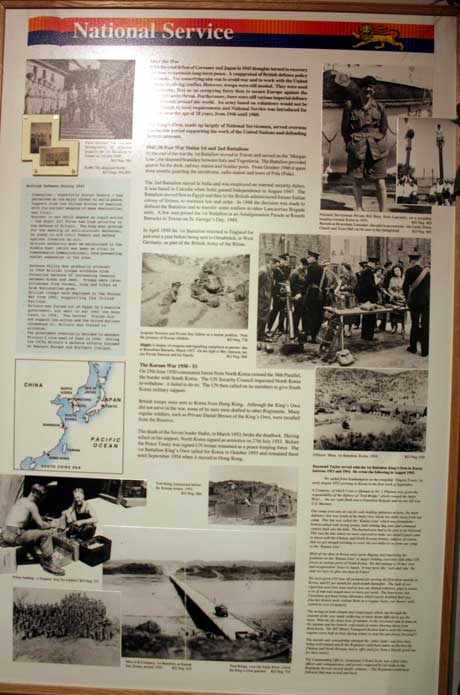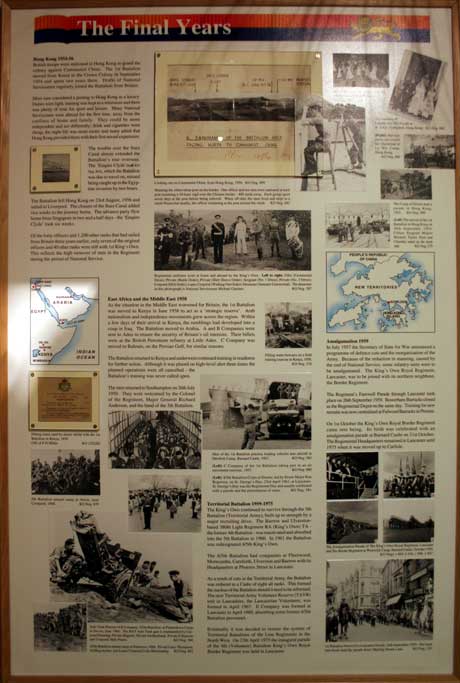1945-50 Post-War Duties 1st and 2nd Battalions
At the end of the war the 1st Battalion moved to Trieste and undertook
occupational duties on the ‘Morgan Line’ the disputed boundary between
Italy and Yugoslavia.
The Battalion provided guards for the dock, railway station, and
frontier posts. From October 1946 the Battalion spent three months
guarding the aerodrome, radio station and town of Pola.
The 2nd Battalion remained in India on internal security duties, and
were based in Calcutta when India obtained its independence in August
1947. The Battalion moved first to Egypt, and then to the British
administered former Italian colony of Eritrea to maintain law and order.
In 1948 the decision was made to disband the Battalion, transferring
some soldiers to other Lancastrian Brigade units. A few men joined the
1st Battalion at an Amalgamation Parade on St. Georges Day, 1949 at
Rosetti Barracks, Trieste.
In April 1950 the 1st Battalion returned to England for just over a year
before being sent to Osnabruck in West Germany, as part of the British
Army of the Rhine.
The Korean War 1950 - 53
On 25th June 1950 communist North Korea crossed the 38th Parallel, the
South Korean border. The UN Security Council called for North Korea to
withdraw. The UN then called for members to render military assistance
to South Korea.
British troops were sent to Korea from Hong Kong. Although the King’s
Own did not serve in the war, men were drafted to other Regiments. Many
regular soldiers were recalled from the Reserve, such as Private Daniel
Brown of the King’s Own.
The death of Soviet leader Stalin in March 1953 broke the deadlock -
North Korea had relied upon his support - and an armistice was signed on
27th July 1953.
Before the Peace Treaty was signed troops remained as a peace keeping
force. The 1st Battalion King’s Own sailed for Korea in October 1953 and
remained there until September 1954 when they moved to Hong Kong.
Raymond Taylor served with the 1st Battalion King’s Own in Korea
between 1953 and 1954. He wrote the following in August 1995.
“We sailed from Southampton on the troopship ‘Empire Fowey’ in early
August 1953 arriving in Korea in the first week of September.”
“A Company, of which I was a rifleman in No. 1 Platoon, was given the
responsibility of the defence of ‘Teal Bridge’ which cross the Imjin
River... On our right flank was a Canadian Brigade and on our left was
U.S. Marines.”
“Our camp area was set out for only holding defensive actions, the main
defensive line was South of the Imjin river about two miles away from
our camp. This line was called the ‘Kansas Line’ which was formidable -
honeycombed with strong points, inter-linking dug outs and command
centres built into the hills. The barbed wire had to be seen to be
believed. This was the line where we were expected to make our stand if
push came to shove with the Chinese and North Korean Armies, subject, of
course, that we got enough warning to cover the two miles or so from our
camp to the ‘Kansas Line’.
“Most of our days in Korea were spent digging and improving the
positions on the ‘Kansas Line’ or major training exercises with other UN
forces in various parts of South Korea.”
“We did manage a 10 day ‘rest and recuperation’ leave to Japan. It was
more like ‘rack and ruin’ the state we were in after ten days in Tokyo!”
“We were given £10 (one off payment) for serving the first three months
in Korea, and £1 per month for each month thereafter. The bulk of our
cigarettes were free issue and so was our limited toiletries, plus in
winter a tot of rum was issued once or twice per week.”
“The Americans and Canadians got hard living allowance which nearly
doubled their pay, plus hot shower units visiting them on a regular
basis, our shower units visited us very irregularly.”
“The swings in both climate and temperature which run through the
seasons of the year made soldiering at times dam difficult to say the
least. With the dry dusty heat of summer, to the torrential rain at
times in the autumn and the bitterly cold winds of winter blowing down
from Manchuria. The MT (Motor Transport) Section had to start the
transport engines every half an hour during winter to stop the
anti-freeze freezing!!!”
“The morale and comradeship amongst the ‘other ranks’ was first class
being well trained and fit the Regiment could have took on the best the
Chinese and North Koreans had to offer and give them a bloody good run
for their money.”
“the Commanding Officer, Lieutenant Colonel Scott, was a first class
officer and communicator, and greatly respected by all ranks in the
Regiment, his war record speaks volume’s.....The Regiment would have
followed that man to hell and back.”
Hong Kong 1954-56
British troops were stationed in Hong Kong to guard against possible
aggression from Communist China. The 1st Battalion moved from Korea to
the Crown Colony in September 1954, and spent two years there. Drafts of
National Servicemen regularly joined the Battalion from Britain.
Most men considered a posting to Hong Kong as a luxury. Duties were
light and training was kept to a minimum, and there was plenty of time
for sport and leisure. Many National Servicemen were abroad for the
first time, away from the confines of home and family, where they could
be more independent and act differently; drink and cigarettes were
cheaper, the night life more exotic, and many admit that Hong Kong
provided them with their first sexual experience.
The trouble over the Suez Canal very nearly extended the Battalions tour
overseas. The ‘Empire Clyde’ on which the Battalion was due to travel
missed being caught up in the Egyptian invasion by two hours.
The Battalion left Hong Kong on 23rd August, 1956 and sailed to
Liverpool with the closure of the Suez Canal adding two weeks to journey
home. The advance party flew from Singapore - taking two and a half days
compared to the six weeks on the ‘Empire Clyde’.
Of the forty officers and 1,200 other ranks who had sailed from Britain
three years earlier, only seven of the original officers, and forty
other ranks were still with 1st King’s Own. This reflected the high
turnover of men during the period of National Service.
The Middle East 1958
In June 1958 the 1st Battalion moved to Kenya to act as a ‘strategic
reserve’ as the situation in the Middle East worsened. Arab nationalism
and independence movements grew across the region. Within only a few
days of their arrival in Kenya, the rumblings of trouble materialised in
a coup in Iraq, and the Battalion were moved to Arabia.
A and B Companies were moved to Aden to ensure the security of Britain’s
oil interests, billets were actually at the British Petroleum refinery
at Little Aden.
C Company was moved to Bahrain, on the Persian Gulf for similar reasons.
The Battalion returned to Kenya and underwent continued training in
readiness for further action. Fortunately the special training was never
called upon - although placed on high level alert three times, the
planned operations were all cancelled.
The Battalion returned to Southampton on 26th July 1959, welcomed by the
Colonel of the Regiment, Major General Richard Anderson, and the band of
the 5th Battalion.
Amalgamation 1959
In July 1957 the Secretary of State for War announced a programme of
defence cuts, and the re-organisation of the Army. Because of the
reduction in manning, caused by the end of National Service, some
infantry units were to be amalgamated.
The King’s Own Royal Regiment, Lancaster, was to be amalgamated with its
northern neighbour, the Border Regiment.
The Regiment’s Farewell Parade through Lancaster took place on 26th
September 1959, the same day Bowerham Barracks closed as the Regimental
Depot with training now centralised at Fulwood Barracks, Preston.
On 1st October the King’s Own Royal Border Regiment came into being with
the amalgamation parade at Barnard Castle on 31st October.
Territorial Battalion 1975
The King’s Own continued to survive through the 5th Battalion
(Territorial Army), which was built up to strength by a major recruiting
drive. The Barrow and Ulverston based 380th Light Regiment RA (King’s
Own) TA, the former 4th Battalion, was reactivated and absorbed into the
5th Battalion in 1960. In 1961 the Battalion was re-designated 4/5th
King’s Own.
The 4/5th Battalion had companies at Fleetwood, Morecambe and Carnforth,
Ulverston and Barrow and Headquarters at Phoenix Street, Lancaster.
As a result of cuts in the Territorial Army the size of the Battalion
was reduced to a Cadre of eight all ranks, which formed the nucleus of
the Battalion should it need to be reformed.
The new Territorial Army Volunteer Reserve (TAVR) unit in Lancashire was
the Lancastrian Volunteers, formed in April 1967. E Company, formed at
Lancaster in April 1969, absorbed some of the former 4/5th Battalion
personnel.
Eventually it was decided to restore the system of Territorial
Battalions of the Line Regiments in the North West. On 27th April 1975
the inaugural parade of the 4th (Volunteer) Battalion King’s Own Royal
Border Regiment was held in Lancaster.
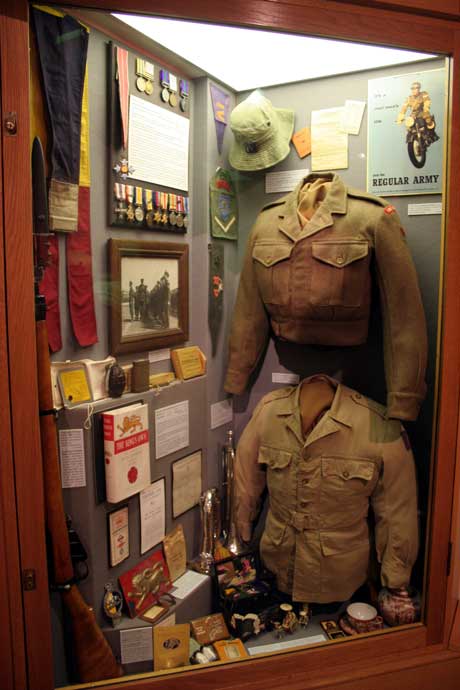
Objects:
5th Battalion recruiting notice.
Accession Number: KO2156/01
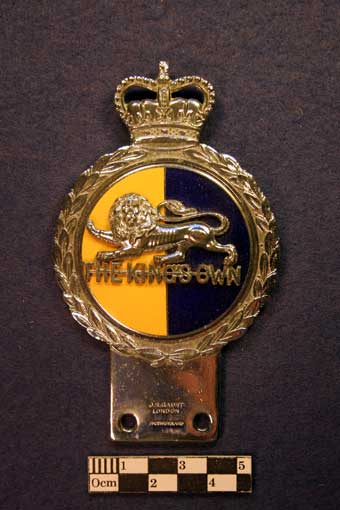
Regimental Car Radiator Badge made by J R Gaunt Ltd. These were
popular with retired officers until the security concerns of the 1970s
saw advice to discontinue their use.
Accession Number: KO1852/01
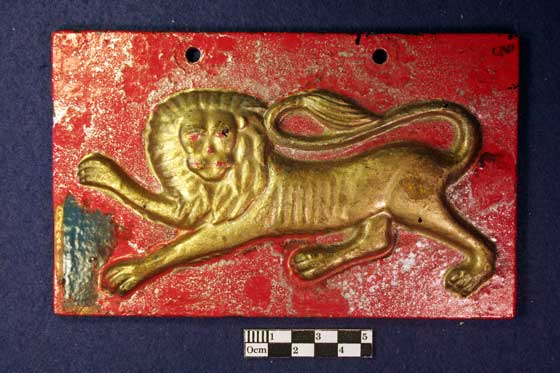
Aluminium badge/plate used on the front of King's Own Land Rovers and
other vehicles in the 1950s.
Accession Number: KO1722/37
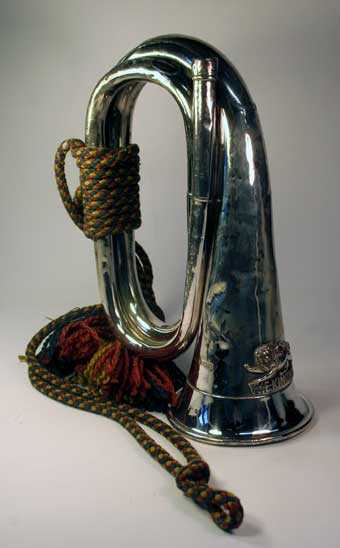
Bugle, silver, with King’s Own
badge. Hallmarked 1928.
Accession Number: KO2173/01
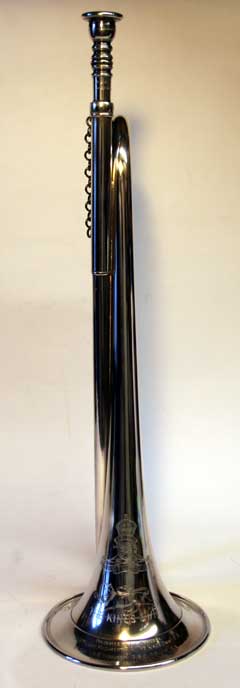
Trumpet, silver, inscribed with
the King’s Own Lion and badge of the Royal Artillery and “Presented to
the Officers 380th Light Regiment RA (The King’s Own) TA by Lieutenant
Colonel J R S Thompson DSO TD JP RA Commanding Officer 1947-51"
Made by Boosey and Hawkes Ltd, England.
Accession Number: KO2693/36
1949 pattern battle dress blouse worn by donor’s husband between 1954
and 1956 whilst with the 1st Battalion.
Accession Number: KO1649/01
Khaki drill bush jacket worn by Private Preston whilst with the 1st
Battalion in Aden and Kenya, 1958.
Accession Number: KO 1683/01
West Lancashire County Cadet Committee certificate awarded to Paul
Thompson of the 5th (King’s Own) Cadet Battalion. Paul chose not to take
up an Army career, but became a museum designer instead and led the
design team on the refurbishment of this gallery.
Accession Number: KO2083/01
London Transport map issued for the 1953 Coronation of Queen Elizabeth
II, used by the donor when representing the 5th Battalion.
Accession Number: KO1395/01
Cover from the third volume of ‘The King’s Own The Story of a Royal
Regiment’ by Colonel Julia Cowper, published in 1959. The first two
volumes, by her father, were published in 1939. Together, the three
volumes form the most authoritative history of any regiment in the
British Army.
Signalling mirror and case.
Accession Number: KO2190/01
Hand grenade.
Accession Number: KO 1722/35
Torch.
Accession Number: KO 1606/05
Spring balance.
Accession Number: KO 1722/03
Solid fuel cooker.
Accession Number: KO 1722/43
Message carrier for use between aircraft and ground troops.
Accession Number: KO 2215/08
Regimental Policeman’s armband used by the 4/5th Battalion King’s Own in
the 1960s.
Accession Number: KO1722/01
Brigadier Hardy, Colonel of the Regiment, inspecting the 1st Battalion
King’s Own Royal Regiment on St George’s Day 1948.
Accession Number: KO1722/55
Commonwealth division armband, worn by the donor whilst with the 1st
Battalion in Korea, around 1954.
Accession Number: KO1131/01
Bush hat worn in Korea and Hong Kong, between 1953 and 1956.
Accession Number: KO0941/01
National Service Enlistment Notice to James Parker of Bamber Bridge who
served in Hong Kong, with the 1st Battalion King’s Own from 1954 to
1956.
Accession Number: KO 2188/01
Kowloon Canton Railways timetable as used by the donor.
Accession Number: KO 2188/03
Private James Parker’s Permanent Pass.
Gift of Mr Parker. KO 2188/04
Home made pennant for use on the staff car of Lieutenant General Sir
Neil Ritchie (Honorary Colonel of the 5th Battalion) during a visit to
the Battalion in 1951. The pennant was made at short notice by Mrs Ford
when her husband was Adjutant of the Battalion.
Accession Number: KO1999/01
General Service Medal with bar ‘Arabian Peninsula’ awarded to Private
Arthur Singleton, who served with the 1st Battalion between 1957 and
1965. The medal was awarded for service in Aden.
Accession Number: KO 1568/01
Korea Medal and United Nations Korea Medal awarded to Private Ninham.
Accession Number: KO 1684/01-02
General Service Medal with bar ‘Malaya’ and United Nations Korea Medal
awarded to Private J T Bulger.
Accession Number: KO 1566/01-02
Brigadier John Herbert Hardy CBE MC
CBE (Military), Military Cross, 1914 Star, British War Medal, Allied
Victory Medal, 1939-45 Star, Africa Star, Defence Medal, 1939-45 War
Medal, and 1937 Coronation Medal.
John Hardy was born on 18th September 1893 and joined the 3rd Special
Reserve Battalion King’s Own in May 1913. He was attached to the 1st
Battalion June 1913.
Hardy was attached to the 1st Battalion on mobilisation, 5th August 1914
and served in the opening actions of the war in France. Second
Lieutenant Hardy obtained a regular commission on 1st September 1914,
six days after his arrival in France. By December 1915 he was a Captain,
and Adjutant of the 1st Battalion, from July 1916 to March 1917. Hardy
received the Military Cross during the Battle of the Somme, but was
wounded in October 1916. On his recovery he served with the Egyptian
Army, from June 1917 until 1921, before rejoining the 1st Battalion
King’s Own.
During the inter war period Hardy served in various positions, as
Adjutant with the 4th (TA) Battalion, with the 2nd Battalion in India
and Sudan and finally commanding the Depot, from 1936 until 1939. As
Lieutenant Colonel he commanded the 2nd Battalion in Palestine and in
the Western Desert.
Hardy’s knowledge of Arabic lead to a number of appointments in the
Western Desert and the Middle East. These included Colonel in charge of
Administration of Cyprus, Commander of the Libyan Arab Force and Acting
Brigadier in Iraq, in 1943. In February 1944 Hardy returned home and
commanded Home Defences in the Mersey Sub-District.
Hardy retired from the Army in February 1947, with the rank of Honorary
Brigadier. He was Colonel of the Regiment from September 1947 to 1957.
During his time in office Hardy was present at the 1st and 2nd
Battalions Amalgamation Parade in Trieste and at the Freedom of the City
of Lancaster Ceremony in August 1953. He died at home, in Lancaster, on
3rd August 1969.
Accession Number: KO1019
© Images are copyright, Trustees of the King's Own Royal Regiment Museum.
You must seek permission prior to
publication of any of our images.
Only a proportion of our collections
are on display at anyone time. Certain items are on loan for display
in other institutions. An appointment is required to consult any of
our collections which are held in store.


